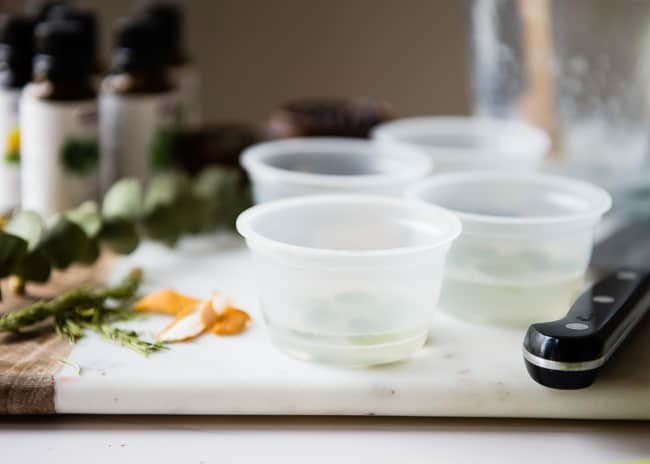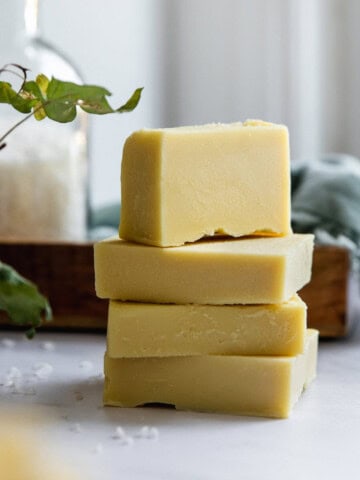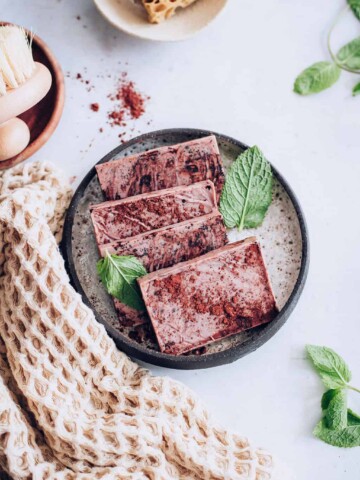If you've ever wanted to try homemade glycerin soap, take note! It's easier than you ever imagined it could be. Seriously, don't be intimidated! It's much less scary than cold process soap with lye. And these pretty melt and pour glycerin soaps are the perfect little gift for a friend, co-worker—or anyone, really.

Melt and pour soap is so fun and easy—you can do just about anything with it. All you really need is a soap mold and a good glycerin soap recipe.
The soap recipe is the perfect place for creative experimentation because it's versatile and easy to work with. You can mix in all kinds of herbs, spices, and citrus peels to make your soaps not only look super cool, but give them a texture that makes each use a sensory experience.
Jump to:
What Is Glycerin Melt and Pour Soap?
Glycerin melt and pour soap is a pre-made soap base that contains glycerin, a natural byproduct of the soapmaking process. It's clear, moisturizing, and can be melted down and poured into molds to create custom soap bars.
Because glycerin soap is loaded with skin-soothing oils and super-emollient glycerin, it helps lock in moisture and prevents drying.
The trick with glycerin melt-and-pour soap is to dress it up with scents, colors, and herbs you have on hand. And, since glycerin is clear, you can see the fun add-ins, like exfoliating ingredients and even fun surprises your kids will love.
Ingredients

- Block of glycerin soap base
- Essential oils
- Dried flowers, herbs, spices, and leaves
- Soap molds - small cups or trays in various sizes (silicone works best)
I have used dried hibiscus flowers and rose petals (mostly because I wanted a pink/red color), loose leaf green tea, and dried rosemary, eucalyptus, juniper berries, and lemon slices. (Note: some dried flowers will change color. The hibiscus turns blue!)
Instructions

Step 1: Prepare the soap base
Chop the glycerin into cubes for easier melting.

Step 2: Melt the soap base
Melt the soap base. This can be done using a double boiler, a small saucepan, or a glass measuring cup in the microwave. I like the measuring cup because it's easier to pour.
Melt over medium-low heat or on 50% power in the microwave. Start with 30-second intervals and stir in between each one. Be careful—it will be very hot!
Remove the measuring cup from the microwave when the soap is almost melted and stir it gently.

Step 3: Add dried ingredients
Once the soap is melted, let it stand and cool for a few minutes before adding additional ingredients. You can add them a couple of different ways:
Mix them with the soap: Before the soap sets too much, stir in the additives. Keep stirring to ensure they don't all float to the bottom. When you have the color you want (more time stirring = darker color) pour into your soap mold.
Put ingredients in the soap molds: Arrange the desired petals, herbs, and leaves into the silicone or soap molds. Carefully fill the molds with the melted soap base.
Make layers: If you want to layer the ingredients, pour a layer of soap, sprinkle some of your mix-ins, and then pour another layer on top.
Step 4: Let the soap harden
Let the soap sit on the counter for about an hour to completely set. If you get bubbles on the top of the soap (and it bothers you) spritz them with rubbing alcohol and they'll go away.
Then put the soap mold in the freezer for another hour or so. Then it should pop right out. Slice the soap with knife, if needed, and give them to someone you love.
Substitutions
Soap base — You can also use shea butter soap base or even goats milk soap base. Both are creamy and moisturizing and also make pretty soaps with ingredients like roses, cocoa, and rosemary.
Dried flowers, herbs, spices — You can use experiment with adding all kinds of different combinations, here are some fun combinations to try:
- Lavender and Lemon Peel: Dried lavender flowers and finely grated lemon peel.
- Rosemary and Orange Peel: Dried rosemary and dried orange peel.
- Peppermint and Cinnamon: Dried peppermint leaves and cinnamon stick pieces.
- Thyme and Clove: Dried thyme and whole cloves.
- Chamomile and Nutmeg: Dried chamomile flowers and a pinch of ground nutmeg.
- Lemongrass and Black Pepper: Dried lemongrass and crushed black pepper.
- Mocha Coffee: Whole coffee beans and a pinch of cocoa powder.
Equipment
We love silicone molds of all shapes and sizes because you can simply peel the soap out once they've cooled—and not think twice about sticking!
You can buy cute soap molds at the craft store or just about any plastic container will work, even your Ziploc containers. Though you might want to use something you can just pitch in the recycle bin when finished rather than trying to clean it.
Use old milk cartons or even yogurt cups. I've used an old creamer carton to make a soap 'loaf' that you can slice into bars. Spray with cooking spray and wipe out excess.
Variation: Fresh Citrus + Herb Glycerin Soaps

You can add fresh herbs or citrus peels to your glycerin soap if they're thoroughly dried to prevent mold growth. Moisture can cause the soap to spoil more quickly.
- Mint: I love the smell and bright green color of mint! Finely dice fresh mint and squeeze out excess water in a paper towel. Add to the soap after the glycerin base is melted.
- Citrus: Zest the peel. You'll need about 1 tablespoon of additives for each cup of soap. Add to the soap after the glycerin base is melted.
Use the soap within 3 months because the mix ins will eventually start to brown.
Troubleshooting Glycerin Soap
Glycerin soap base is as easy as it comes. But there are still a few things you can do to get gift-worthy soaps without the fuss. Here are some of our tips for working with glycerin melt-and-pour soap.
Use powdered colorant
We didn't add colors to our soaps, but you can if you want to! Liquid colorants don't mix too well with glycerin soap, but dry colorants do. Simply take a small amount of melted soap base and pour it into a separate cup.
Add your colorant (beetroot powder, turmeric, cinnamon, or other colored herb powders work well for this), and stir well until completely blended. Then pour this small bit of soap into your larger batch of soap and mix well.
Prevent bubbles with rubbing alcohol
If you have a hard time keeping bubbles from forming on the walls of your molds, spritz each mold with a bit of rubbing alcohol. Then pour in your soap. This helps dilute the soap for a few seconds, so it dries smooth and clear.
Sweating
Glycerin is a humectant, which means it draws moisture from the air to itself. This can cause glycerin soap to "sweat" in humid environments.
To minimize sweating, try wrapping your finished soaps in plastic wrap or storing them in an airtight container.
Let the soap cool before adding your mix-ins
Hot soap can't suspend your herbal add-ins very well, so they sink to the bottom. To prevent this, melt your soap and let it cool for about 5–10 minutes before pouring it into your molds.
Then add your herbs/spices. If done at the right time, they should float in the center of the soap rather than sink to the bottom.
FAQ
You certainly can make your own glycerin soap from scratch at home, but it's a lot more complicated than just adding liquid glycerin to the soap base. You need oils, lye, and glycerin to start, plus a whole bunch of equipment to prevent chemical burns. We still believe that melt-and-pour soap is the easier, more enjoyable option.
Local craft stores usually have it. You can also find it on Amazon or online soap-making stores.
Yes, you can add both color and fragrance to glycerin soap bases. Use soap-safe dyes or mica powders for coloring, and essential oils or fragrance oils specifically designed for soapmaking for scent. Be sure to add these ingredients when the soap is melted but not too hot, to preserve the fragrance and prevent the color from degrading.
Yes, one of the benefits of melt and pour soap is that it can be melted down again if you're not satisfied with your initial results. However, frequent reheating can degrade the quality of the soap, so it’s best to avoid doing it multiple times.
Homemade Glycerin Soaps
Equipment
- Double boiler, saucepan or glass measuring cup
- Silicon mold or small plastic cups
Materials
- Dried flowers and/or leaves Dried rosemary, eucalyptus, hibiscus, juniper berries, or dried citrus peels
- Glycerin melt-and-pour soap
- Essential oils Eucalyptus, lemon, rosemary, orange, etc.
- Molds - cups or trays in various sizes Silicone works best
Instructions
- Cut the glycerin soap into pieces.
- Melt according to package directions. Then carefully and slowly add the essential oils, about 5 drops per ounce of soap used. Stir gently and slowly to prevent bubbles from forming. Gently rap the jar or container on the countertop to release any larger trapped air bubbles.
- Place your molds (I used plastic cups) on a flat surface and drop dried flowers or herbs into into the bottom of each mold. Then carefully fill each one with the melted soap base.
- Let cool completely, about 1 hour. Pop soap out of the molds and let cool completely.
Notes
This post was medically reviewed by Dr. Jennifer Haley, a board-certified dermatologist with extensive experience in medical, cosmetic and surgical dermatology. Learn more about Hello Glow’s medical reviewers here. As always, this is not personal medical advice and we recommend that you talk with your doctor.
555




